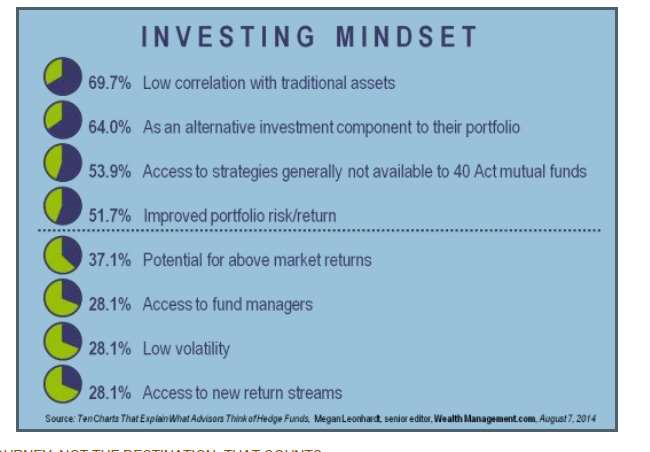 By Diane Harrison
By Diane Harrison
With the third quarter of 2014 coming to its close, and year-end allocation decisions taking precedence in the minds of advisors and managers both, it seems a good time to take a look at an interesting survey result recently appearing on WealthManagement.com. The publication asked over 300 advisors throughout the industry to share their views on hedge funds (Ten Charts That Explain What Advisors Think of Hedge Funds, by senior editor Megan Leonhardt, August 7, 2014). The survey answers are expected in their scope, but the prioritization of drivers lends a new perspective to marketing alternative products that bears exploring.
Alternative marketing typically devotes much time and communication on emphasizing the product’s ability to generate performance and lower volatility for investors, hitting on the twin motivators of increasing return with lessening risk. While both factors are investment goals for the investor, the survey results indicate that neither are actually majority interests for advisors
positioning new alternative products to their clients. The chart below summarizes the priority order of what advisors are currently influenced by in evaluating alternatives for their clients:

IT’S THE JOURNEY, NOT THE DESTINATION, THAT COUNTS
It is worth noting that joining the performance and low volatility factors as minority persuaders is access to fund managers and new return streams. Again, both of these attributes receive much time and effort from marketers seeking to draw advisors to their alternative products. While performance and volatility are clearly in the mind of an advisor, they are not necessarily the areas that marketers should be hitting hardest when pleading their cause in investment meetings.
The top four reasons advisors are compelled to consider alternative products in their client portfolios are correlation, an investment “difference” in portfolio construction, strategies that are unique or difficult to replicate in more traditional structures, and an overall strengthening of a portfolio’s risk/return relationship. What this suggests is that advisors are more influenced by the manner, or the ‘how factor,’ in which alternatives impact a portfolio, than in their pure performance or marquee manager. This is good news for smaller alternatives managers, who are less able to compete for investors with the big brand names and established players already known to advisors. Smaller managers can focus their marketing efforts on defining themselves within the four factors that advisors weigh most heavily to gain access to and investment with these advisor clients. The following are some thoughts regarding these top four influencers and how to exploit them in alternatives marketing.
CORRELATION--OR THE LACK THEREOF--TRUMPS PERFORMANCE
It’s not that surprising that ‘correlation contagion,’ or all asset classes moving in lockstep, still looms large in the minds of investment management advisors. With political unrest sparking in the Middle East and conflicting economic data weighing on traditional and nontraditional asset classes, unique strategies that march to their own drummer in outcome are increasingly
desirable to all investors. An advisor stated to WealthManagment.com “The ability to construct shorts within the portfolios permits advisers and clients to invest in ways that contrast with the traditional methods of generating alpha.”
While alpha is always a welcome addition, securing downside protection is a higher priority in long-term performance. Low correlation, formerly viewed as a secondary statistic when evaluating an alternative product, has clearly taken center stage in an advisor’s consideration process. Smaller or emerging managers who can showcase their funds relative to traditional assets and provide compelling correlation comparisons will be able to sidestep some of the ‘name brand’ recognition barriers they have struggled against in the past.
ALTERNATIVES ARE BECOMING MORE MAINSTREAM IN PORTFOLIO CONSTRUCTION
The survey also found that half of advisors don't currently invest in hedge funds but would consider doing so. While the reasons for this vary widely, the importance of this statistic is that there is a huge market of advisors waiting to be persuaded to join in alternatives investing. Wealth management as a discipline is becoming more like institutional investing than as a financial advisory service. Both advisors and clients believe that portfolio investment management for the high net worth market should incorporate many of the successful techniques already mainstream for institutional investors.
This includes portfolio construction that includes diverse return streams, a longer-term investment horizon, and sophisticated, comprehensive dissection of risk components to determine the right ratio of return/risk for each client portfolio. Alternatives managers who articulate their offerings in ways that play into this hybrid ‘individualized institutional’ manner can hope to find success in gaining the attention of advisors who feel they should be looking at alternatives but currently aren’t doing so.
NOT ALL APPROACHES COME WITH DAILY LIQUIDITY (AND SHOULDN’T)
One of the main differences in alternatives versus traditional investments is the wide diversity of liquidity access based upon strategy approach. Equity or index-based strategies can offer equivalent liquidity to most mutual funds while private equity funds often have 7-10 year lockups, sometimes longer, for investors. In between these extremes is a range of strategies and structures that typically offer monthly or quarterly liquidity for the vast majority of alternatives products today. Once an advisor can get over the liquidity ‘bugaboo’ of forgoing daily access to liquidity, the consideration and valuation of the actual strategy of an alternative product can be assessed. As evidenced by the 54% of advisors who believe they can find strategies within alternatives not available to them in ‘40 Act structures, today’s advisor mindset is more receptive to accepting lower liquidity characteristics in return for unique or attractive alternative approaches. Again, managers who can explain their strategy’s value and its relative liquidity as a key component of an investor’s portfolio not easily replicable within traditional structures will do well in gaining notice from a majority of advisors who now seem to be open to considering these non-traditional products.
THE ENDS WILL JUSTIFY THE MEANS
The relationship between risk/return has always been a primary investment objective marker for advisors, but as in most things that seem basic, there are many paths to the same destination. Balancing the short, medium, and longer-term journey a portfolio can take to achieve a desired performance outcome is a complex and delicate dance. Advisor and manager careers have been made and unmade on the ability to manage this risk/return relationship for investors. Therefore, it’s no surprise that improving a portfolio’ risk/return remains a majority interest of advisors today. The 52% of advisors who prioritized the risk/return ratio are telegraphing their desire to gain a greater understanding of each alternative product’s relationship between risk/return and how that can impact an overall portfolio.
The good news is that both investors and advisors are moving their focus farther out on the return objective timeline, allowing for a more institutional focus to weather short-term performance ‘blips’ and foregoing a tendency to shift allocations at the first sign of a performance dip. This is positive for those alternatives managers who have developed an approach that is unique or specialized but requires a longer-term focus to realize is stated objective. Many strategies favored by alternatives managers are prone to periods of choppy market behavior where the strategy calls for a de-levering of the stated investment approach until the market presents opportunities to exploit again. This deleverage time is less of a problem for private equity vehicles, where investor capital is committed long-term, than in more fluid hedge fund structures, in which managers are exposed to a more lenient liquidity policy. Managers with accessible liquidity features should take extra care in educating and informing advisors of when and why a strategy might not be fully employed during certain market conditions so that greater understanding is achieved for both advisors and clients when flatter or downside performance impacts the strategy’s ability to exploit the market.
In all, advisors appear to be concentrating their attention on evaluating alternatives with an eye towards the overall impact such investments will have on investor’s total portfolio management. This indicates a real shift in acceptance of alternatives as a building block of portfolio construction. With over half of the advisor universe professing a desire to understand alternatives better in order to recommend them to their clients, managers can capitalize on educating these professionals about their fund offerings and grow their business.
Diane Harrison is principal and owner of Panegyric
Marketing, a strategic marketing communications firm founded in 2002 and specializing in a wide range of writing services within the alternative assets sector. She has over 20 years’ of expertise in hedge fund marketing, investor relations, sales collateral, and a variety of thought leadership deliverables. Panegyric Marketing received consecutive year awards in 2013-14 as IHFA’s Innovative Marketing Firm of the Year and AI’s Marketing Communications Firm of the Year- US. A published author and speaker, Ms. Harrison’s work has appeared in many industry publications, both in print and on-line.
Contact: dharrison@panegyricmarketing.com or visit www.panegyricmarketing.com.



